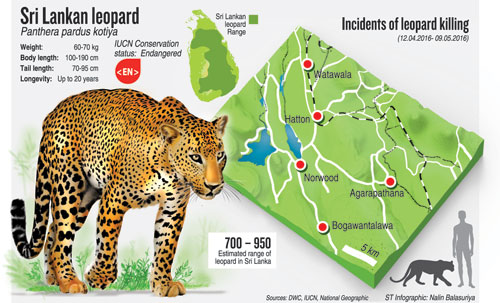News
Too many leopards dying in the hills

At least 10 leopards have died during the past seven months in the hill areas, an official at the Nuwara Eliya Range Office disclosed
An alarming rise in leopard deaths in upcountry tea plantations has prompted police to begin an awareness campaign to avert deepening leopard-human conflict.
On Tuesday, a plantation worker was severely injured when a leopard attacked him, springing out from tea bushes on the Q estate at Bogawantalawa.
The move to create safety awareness among tea pluckers came after three tea pluckers fainted on Monday when they saw a leopard in the plantation. The three women were admitted to Akkaraipathanai Hospital for treatment and later discharged.
Two leopards have been found dead on the Elpian estate in Akkaraipathanai area this week alone. People residing in line rooms complained the presence of leopards has become common during the nights as they come hunting for chickens and dogs.
Sri Lankan leopards are one of the rarest cat species in the world. Their incursion into human habitat in search of food is creating a serious threat to their numbers.
At least 10 leopards have died during the past seven months in the hill areas, an official at the Nuwara Eliya Range Office disclosed.
In recent weeks, at least five leopards and two wildcats were found dead in Norwood, Watawala, Hatton, Bogawantalawa and Akkaraipathanai after being poisoned or trapped.
Dr. Tharaka Prasad, Chief Veterinary surgeon of Department of Wildlife Conservation who went for a field visit to Nuwara Eliya this week observed that the increasing deaths of leopards in upcountry areas is disturbing compared to their state elsewhere in the country.
He declared, however, that only five and not seven leopards had died in the recent past, saying the other two animals had been fishing cats or wildcats that belong to the cat family.
“Leopards live in natural forests adjacent to mountains and valleys and have started to move to human settlements for hunting when they don’t find anything to survive on,” he said.
Dr. Prasad believes the recent increase of stray dogs in the neighbourhood of tea planters’ line rooms is also one of the reasons why leopards move to human settlements more often by day and night.
“During my field trips near tea plantation hills around Adam’s Peak I noticed a path like a tunnel used by animals to access the adjacent forest. People set up traps along this way to prevent leopards coming to their houses,” he said, pointing out that some leopards have died due to trapping.
Anjali Watson, an ecologist and a managing trustee of the Wilderness and Wildlife Conservation Trust said the current population of leopards in Sri Lanka is about 750 to 1,000 based on its breeding level but the incidents of killing and trapping these animals is increasing.
“Every year, at least five incidents of leopard deaths are recorded but this year there is an escalation in the number of incidents within a short time. It could be due to the drought or change of landscape of the upcountry area,” she said.
The Director-General of the Department of Wildlife Conservation, Dr. Sumith Pilapitiya, said that in view of these recent deaths of leopards a Rapid Response Team has been set up in upcountry areas to act immediately whenever an incident occurred.
“We have found some leopards killed in wire snares used to trap wild bear by the estate workers. We have also started awareness campaigns for the plantation workers to keep their pet dogs in kennels to keep them from being attacked by leopards,” he said.
The Nuwara Eliya Range office has also sought military help for night patrolling for public safety. .nd for assistance in removing wire snares set near line rooms.

